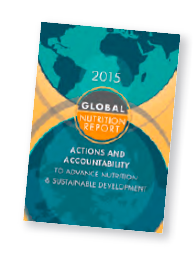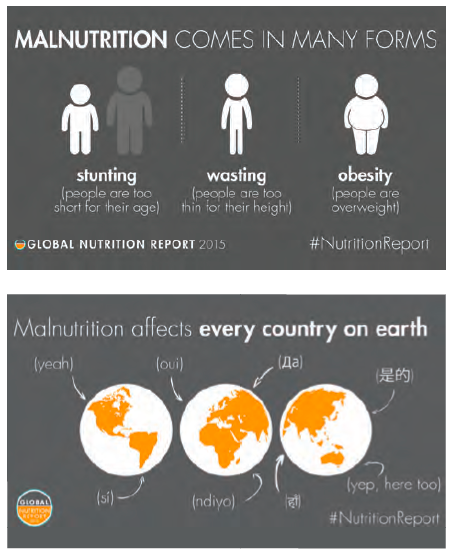2016 Global Nutrition Report From Promise to Impact: Ending Malnutrition by 2030
 By Lawrence Haddad, Corinna Hawkes and Emorn Udomkesmalee, Global Nutrition Report Independent Expert Group Co-Chairs
By Lawrence Haddad, Corinna Hawkes and Emorn Udomkesmalee, Global Nutrition Report Independent Expert Group Co-Chairs
Ending malnutrition by 2030 is a lot to ask, but the ground has never been more fertile for a step change in the level of commitment to high-impact actions for nutrition improvement. Momentum around nutrition has been building over the last decade, and the inclusion of a commitment to “ending all forms of malnutrition” in the UN Sustainable Development Goals (SDGs) challenged the world to think and act very differently on malnutrition: to focus on all its aspects and try to end it – for all people – by 2030. 2016 brings major opportunities to translate this commitment into action, with the adoption of SDG targets at country level, the Nutrition for Growth (N4G) process, and with Japan’s growing leadership on nutrition as part of its G20 leadership and in advance of the 2020 N4G summit.
In light of these opportunities, this year’s Global Nutrition Report (GNR) – the third in the series – focuses on the theme of making and measuring SMART (specific, measurable, achievable, relevant and time-bound) commitments to nutrition, and what it will take to end malnutrition in all its forms by 2030. The report aims to make it easier for governments and other stakeholders to make high-impact commitments to ending malnutrition in all its forms. Equally importantly, the 2016 GNR aims to make it harder for stakeholders to avoid making such commitments.

At the same time, the 2016 GNR outlines how business-as-usual is a recipe for failure: every country is facing a serious public health challenge from malnutrition, with diet the number one factor in the global disease burden. With business-as-usual, we would reach global nutrition goals by the late 21st century, if at all. Ending malnutrition is ultimately a political choice: nowhere is this clearer than by comparing the different nutrition choices that otherwise similar countries make.
This year’s report has a particularly strong focus on malnutrition in all its forms, including overweight, obesity and nutrition-related, non-communicable diseases. It also underlines the need to consider all forms of malnutrition in country-level planning and measurement, as many countries face the challenge of multiple forms of malnutrition.
The 2016 GNR offers guidance to governments and other stakeholders on:
- Why commitments matter: they are a signal of intent; they can provide a direction of travel for everyone; and they seem to go hand-in-hand with improved performance.
- Where to make commitments: which geographical areas and which sectors.
- Who the commitments are being made for: which age, gender and socioeconomic groups.
- How SMART, ambitious and aligned some of our current commitments are, and how all our commitments to nutrition could be more so.
- What kinds of commitments to make: which policies and programmes to commit to and what level of funding is available and required; and
- Who needs to do what and by when.
The Global Nutrition Report will launch on 14 June 2016 in a number of locations (including Washington DC, Sweden and Kenya). If you would like to get involved or follow what’s happening, please follow us on @GNReport on twitter, or contact josephinelofthouse@me.com
The Global Nutrition Report is an independent and comprehensive annual review of the state of the world’s nutrition. It is a multi-partner initiative that holds a mirror up to progress on meeting inter-governmental nutrition targets. It documents progress on commitments made on the global stage and makes recommendations for actions to accelerate progress.
You can find out more and see our very useful country nutrition profiles here.

